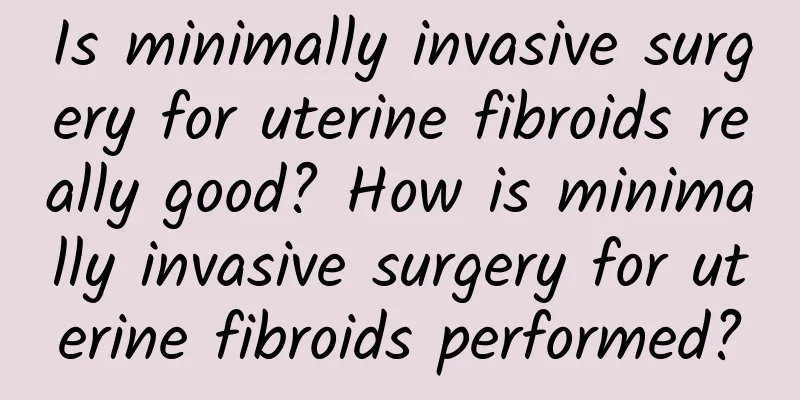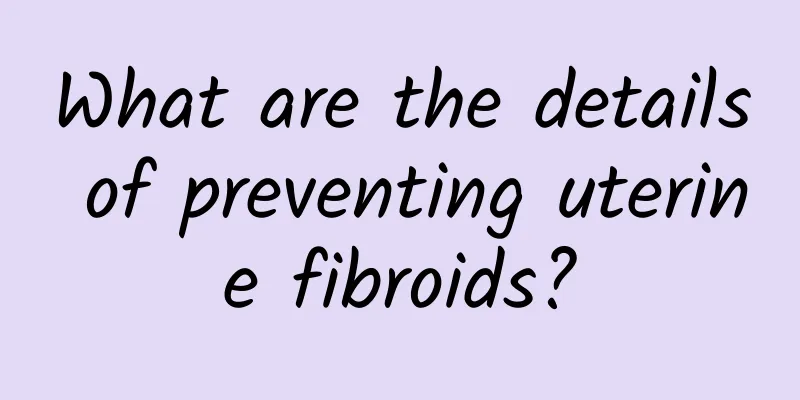Is minimally invasive surgery for uterine fibroids really good? How is minimally invasive surgery for uterine fibroids performed?

|
Uterine fibroids are a common gynecological tumor disease. Suffering from this disease will inevitably have an impact on the patient's life. There are many symptoms of uterine fibroids. If female friends find these symptoms, they should pay attention. This is likely a prelude to uterine fibroids. We need to find a good treatment method to deal with it. So, is minimally invasive surgery for uterine fibroids good? What are they? Common minimally invasive treatments for uterine fibroids include laparoscopic surgery, superconducting ablation interventional surgery, and Da Vinci robotic surgery. It can use less trauma to help patients recover, with ideal results and is trustworthy. 1. Laparoscopy. With the improvement of laparoscopic surgery and equipment, laparoscopy has been maturely applied in gynecological clinical surgery. Laparoscopy only requires opening 3-4 holes of about 0.5-1 cm in the patient's abdomen to remove uterine fibroids under the scope. It is a minimally invasive treatment method with small abdominal incision and fast postoperative recovery. It has the advantages of short hospitalization time, less bleeding, and fast recovery. 2. Superconducting ablation intervention. What are the minimally invasive treatments for uterine fibroids? Superconducting ablation surgery, as a non-invasive treatment method, can accurately locate the lesion without surgery or hospitalization, and then through the thermal effect generated by high-frequency oscillation, the local tissue of the lesion undergoes irreversible degeneration, coagulation and necrosis, achieving in situ extinguishing of the fibroids, and eventually the uterine fibroids disappear or shrink. It has the advantages of less trauma, no need for hospitalization, and faster recovery. 3. Fibroid dissection under robotic surgery. Robotic surgery is an advanced technology for the treatment of uterine fibroids. Through three-dimensional imaging technology, the abdominal field of view is expanded 10 times, greatly improving the accuracy and stability of the operation. During the operation, the robot can flexibly use the manipulator with 7 degrees of freedom to penetrate into the patient's narrow surgical field, making traditional laparoscopic surgery more difficult and simple and convenient to operate. It has the advantages of wide field of view, wide surgical range, and less trauma, and has a significant effect on difficult uterine fibroids. |
Recommend
How much does uterine fibroid surgery cost?
We know that uterine diseases can cause a lot of ...
Treatment of second degree cervical erosion
Treatment of second degree cervical erosion Cervi...
Reminder to women: These 5 behaviors will hurt the vagina. Do you do them often?
At the gynecology clinic, I met a 28-year-old Lil...
My period has stopped for a few months, what's going on?
If your period comes back after a few months of a...
Can I still get pregnant after having cervical precancerous lesions?
Although the chance of pregnancy for patients wit...
What should you pay attention to in order to completely cure candidal vaginitis?
Candidal vaginitis is a common gynecological infl...
Can eating pasta help you lose weight? Study: Eating 3.3 servings a week can help you lose 0.5 kg
We often hear people say that when losing weight,...
Can I eat carrots after a miscarriage? It is best not to eat them
Can you eat carrots after a miscarriage? Carrots ...
What is the cause of heavy menstrual flow during puberty?
What is the cause of heavy menstrual flow during ...
Cost of chemotherapy for cervical precancerous lesions
The key to treatment is early stage. Some patient...
Pay attention to diet when leucorrhea is abnormal
Abnormal vaginal discharge in women is mainly cau...
What are the factors that affect the cost of cervical warts?
Presumably, most women with cervical warts are no...
Three dangers of ectopic pregnancy that should be watched out for
Among many common gynecological diseases, ectopic...
What medicine should elderly people take for uterine fibroids? What is the best way to treat uterine fibroids in the elderly?
What medicine should elderly people take for uter...
What is menopausal irregular menstruation? There are 3 common ways to regulate menopausal irregular menstruation.
Menopausal women are also prone to irregular mens...









